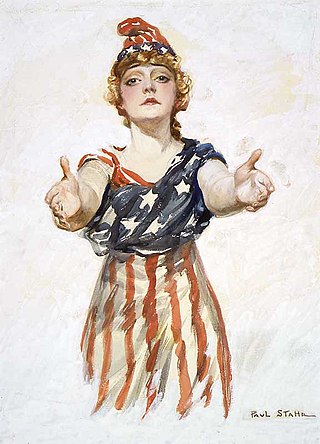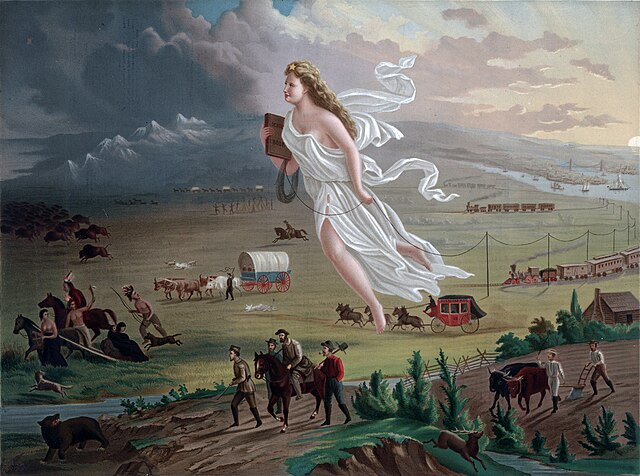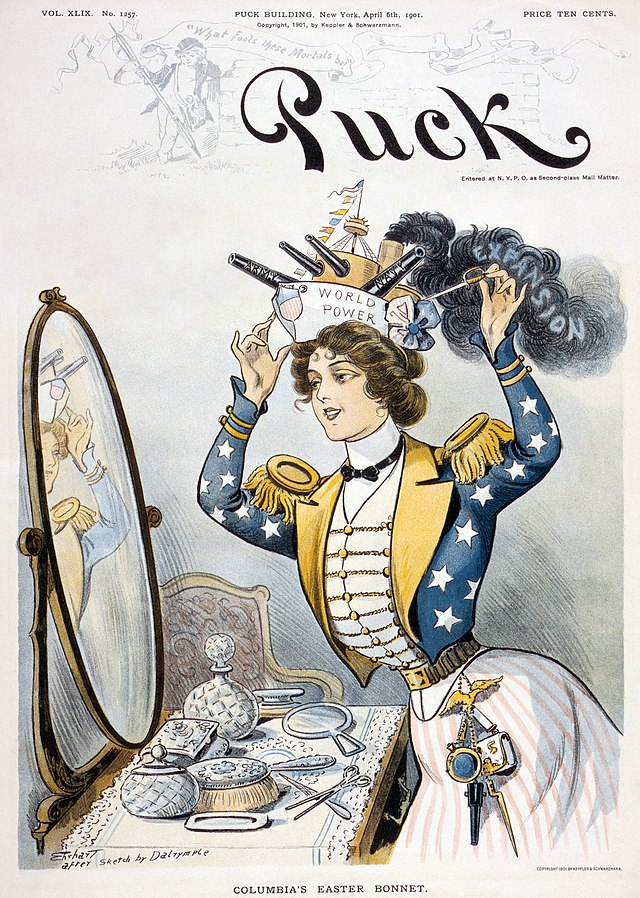Loading AI tools
Female national personification of the United States From Wikipedia, the free encyclopedia
Columbia (/kəˈlʌmbiə/; kə-LUM-bee-ə), also known as Lady Columbia, Miss Columbia is a female national personification of the United States. It was also a historical name applied to the Americas and to the New World. The association has given rise to the names of many American places, objects, institutions and companies, including the District of Columbia; Columbia, South Carolina; Columbia University; "Hail, Columbia"; Columbia Rediviva; and the Columbia River. Images of the Statue of Liberty (Liberty Enlightening the World, erected in 1886) largely displaced personified Columbia as the female symbol of the United States by around 1920, and Lady Liberty was seen as both an aspect of Columbia[1] and a rendition of the Goddess of Liberty. She is the central element of the logo of Hollywood film studio Columbia Pictures.

Columbia is a Neo-Latin toponym, used since the 1730s to refer to the Thirteen Colonies that would form the United States. It originated from the name of the Genoese explorer Christopher Columbus and from the Latin ending -ia, common in the Latin names of countries (paralleling Britannia, Gallia, Zealandia, and others).

The earliest type of personification of the Americas, seen in European art from the 16th century onwards, reflected the tropical regions in South and Central America from which the earliest European travelers reported back. Such images were most often used in sets of female personifications of the four continents. America was depicted as a woman who, like Africa, was only partly dressed, typically in bright feathers, which invariably formed her headdress. She often held a parrot, was seated on a caiman or alligator, with a cornucopia. Sometimes a severed head was a further attribute, or in prints scenes of cannibalism appeared in the background.[2][3]
Though versions of this depiction, tending as time went on to soften the rather savage image into an "Indian princess" type, and in churches emphasizing conversion to Christianity, served European artists well enough, by the 18th century they were becoming rejected by settlers in North America, who wanted figures representing themselves rather than the Native Americans they were often in conflict with.[4]
Massachusetts Chief Justice Samuel Sewall used the name "Columbina" for the New World in 1697.[5] The name "Columbia" for America first appeared in 1738[6][7] in the weekly publication of the debates of Parliament in Edward Cave's The Gentleman's Magazine. Publication of parliamentary debates was technically illegal, so the debates were issued under the thin disguise of Reports of the Debates of the Senate of Lilliput and fictitious names were used for most individuals and place names found in the record. Most of these were transparent anagrams or similar distortions of the real names and some few were taken directly from Jonathan Swift's Gulliver's Travels while a few others were classical or neoclassical in style. Such were Ierne for Ireland, Iberia for Spain, Noveborac for New York (from Eboracum, the Roman name for York) and Columbia for America—at the time used in the sense of "European colonies in the New World".[8]

By the time of the Revolution, the name Columbia had lost the comic overtone of its Lilliputian origins and had become established as an alternative, or poetic, name for America. While the name America is necessarily scanned with four syllables, according to 18th-century rules of English versification Columbia was normally scanned with three, which is often more metrically convenient. For instance, the name appears in a collection of complimentary poems written by Harvard graduates in 1761 on the occasion of the marriage and coronation of King George III.[11]
The name Columbia rapidly came to be applied to a variety of items reflecting American identity. A ship built in Massachusetts in 1773 received the name Columbia Rediviva and it later became famous as an exploring ship and lent its name to new Columbias.


No serious consideration was given to using the name Columbia as an official name for the independent United States, but with independence, the name became popular and was given to many counties, townships, and towns as well as other institutions.
In part, the more frequent usage of the name "Columbia" reflected a rising American neoclassicism, exemplified in the tendency to use Roman terms and symbols.[citation needed] The selection of the eagle as the national bird, the heraldric use of the eagle, the use of the term Senate to describe the upper house of Congress and the naming of Capitol Hill and the Capitol building were all conscious evocations of Roman precedents.
During the Civil War, the Union faced a coin shortage and issued Fractional currency depicting busts of George Washington and others, as well as allegorical figures such as Columbia and Liberty. The Confederacy also issued currency depicting allegorical figures such as Columbia and Liberty. However, Columbia depicted on these is very similar to the Progress of Civilization Pediment on the United States Capitol building.


Those on the Union side drew Columbia and the flag on envelopes to show their allegiance to the Union.


"Columbia, the Gem of the Ocean" became popular during the Civil War. The song has lyrics praising the Union in the third verse. (Today, this part is usually not sung.) [14]
The Union, the Union forever,
Our glorious nation's sweet hymn,
May the wreaths it has won never wither,
Nor the stars of its glory grow dim,
May the service united ne'er sever,
But they to their colors prove true.
The Army and Navy forever,
When borne by the red, white, and blue.
𝄆 When borne by the red, white, and blue. 𝄇
The Army and Navy for ever,
Three cheers for the red, white and blue.[15]
Her statue is used on many of the Civil War monuments. Some of them are listed in this page.
In the early 20th century, women dressed up as Columbia in parades to appeal for women's suffrage.

Early in World War I (1914–1918), the image of Columbia standing over a kneeling "doughboy" was issued in lieu of the Purple Heart medal. She gave "to her son the accolade of the new chivalry of humanity" for injuries sustained in the World War.
In World War I, the name Liberty Bond for savings bonds was heavily publicized, often with images from the Statue of Liberty (Liberty Enlightening the World). The personification of Columbia fell out of use and was largely replaced by the Statue of Liberty as a feminine symbol of the United States.[16]
After Columbia Pictures adopted Columbia as its logo in 1924, she has since appeared as bearing a torch similar to that of the Statue of Liberty, unlike 19th-century depictions of Columbia. The Columbia Pictures logo is the most famous and prominent display of Columbia to many current Americans.[17]
In 2023, on the commemorative medal issued by the U.S.Mint, Columbia does not wear a Phrygian cap and does not carry a weapon or shield as in the World War I poster. Instead, Columbia is holding an American flag and shaking hands with an American Indian. Between them sits a bust of Washington and the inscription "PEACE." Around them are elements symbolic of American life, both native and industrial. This medal is a reproduction of one issued in the 19th century.[18] On a commemorative coin issued in 2024 depicting Liberty, the designers studied not only the liberty but also the portrayal of Columbia to depict liberty. The race of Liberty depicted on this coin is ambiguous.[19] Like other national symbols such as Marianne, Britannia, and Liberty, Columbia's appearance and depiction has changed over time as a national symbol.[20]
The adjective Columbian has been used to mean "of or from the United States of America" such as in the 1893 World's Columbian Exposition held in Chicago, Illinois. It has occasionally been proposed as an alternative word for American.
Columbian should not be confused with the adjective pre-Columbian, which refers to a time period before the arrival of Christopher Columbus in 1492.

As a quasi-mythical figure, Columbia first appears in the poetry of the African-American Phillis Wheatley in October 1775, during the Revolutionary War:[21][22]
One century scarce perform'd its destined round,
When Gallic powers Columbia's fury found;
And so may you, whoever dares disgrace
The land of freedom's heaven-defended race!
Fix'd are the eyes of nations on the scales,
For in their hopes Columbia's arm prevails.[23]

Especially in the 19th century, Columbia was visualized as a goddess-like female national personification of the United States and of liberty itself, comparable to the British Britannia, the Italian Italia Turrita and the French Marianne, often seen in political cartoons of the 19th and early 20th century. The personification was sometimes called Lady Columbia or Miss Columbia. Such an iconography usually personified America in the form of an Indian queen or Native American princess.[25] The image of the personified Columbia was never fixed, but she was most often presented as a woman between youth and middle age, wearing classically draped garments decorated with stars and stripes. A popular version gave her a red-and-white-striped dress and a blue blouse, shawl, or sash, spangled with white stars. Her headdress varied and sometimes it included feathers reminiscent of a Native American headdress while other times it was a laurel wreath, but most often, it was a cap of liberty.




Statues of the personified Columbia may be found among others in the following places:

Since 1800, the name Columbia has been used for a wide variety of items and places:


Seamless Wikipedia browsing. On steroids.
Every time you click a link to Wikipedia, Wiktionary or Wikiquote in your browser's search results, it will show the modern Wikiwand interface.
Wikiwand extension is a five stars, simple, with minimum permission required to keep your browsing private, safe and transparent.